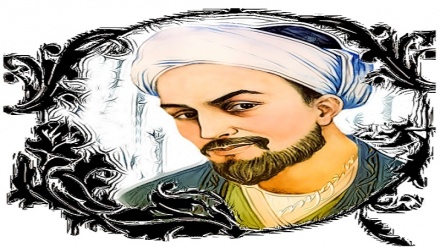Iranian notables, sources of global honor (187)
Welcome to this week's episode of the series Iranian Notables, Sources of Global Honor. Today, we continue to discuss the life of the great Iranian mystic of 3rd Century AH, Hussein ibn Mansour Hallaaj.
Despite of all efforts which have been carried out by oriental scholars and other researchers in order to discover the life and activities of this great mystic, his life remains shrouded in obscurity. Meanwhile, among the researchers, who have made efforts to gain an understanding of the life of Hallaaj; the French Orientalist, Louise Masinion leads others. This oriental scholar has authored and compiled a number of books on this topic.
This mystic's name was Hussein, while his father was named Mansour. In ancient texts, no reference has been made to his date of birth. The Islamic encyclopedia has pointed out his date of birth as 858 AD. Three French oriental scholars, namely Louise Masinion, Henry Corbin, and Roger Arnaldez, have also stated the same year of birth for this great Iranian mystic. However, these French orientalists have not provided any evidence in their compilations in order to prove their claim. It seems as though they have guessed this mystic's date of birth based on the developments of his life.
Hallaaj was born in Toor Village in Fars Province. He accompanied his family in their migration to Iraq, throughout his childhood. Hussein ibn Mansour earned the title of Hallaaj, which means cotton-beater. After a while, his real name was overshadowed by his title, and he became popularly known as Hossein ibn Mansour Hallaaj.
This famed Iranian mystic left the city of Vaaset at a young age and headed toward the city of Ahwaz in southern Iran, in order to attend the classes of the renowned Iranian mystic, Sohl ibn Abdullah Testari. Hallaaj learned the principles of mysticism from his lecturer, while leaving the city of Ahwaz in the year 262 AH, to benefit from the vast knowledge of the prominent lecturer, Amr ibn Ottoman. He settled down in the city of Basra for 1.5 years, excelling significantly in mysticism. Amr ibn Ottoman Makki realized that Hossein ibn Mansour was going to glitter in the spiritual realm. Throughout this phase in time, Hallaaj married that daughter of Abu Yaqoub Aqta, despite the opposition of Amr ibn Ottoman to this marriage, leading to a dispute between this lecturer and student. It is said that Abu Yaqoub Aqta and Amr ibn Ottoman Makki rivaled over the leadership of Sufis in Basra, and each one of them wanted Hallaaj on their side. Meanwhile, Hallaaj, who had sought refuge at Basra Mosque, worshipping God and reciting ayahs of Holy Quran, was saddened by the dispute between the said two figures, leaving Basra and settling in Baghdad, joining the supporters of the well-known Iranian mystic, Junaid.
Hallaaj began his activities and started to make his remarks upon his return from Mecca to Baghdad in the year 294 AH. In this city, he advised people for the first time, and revealed the hypocritical Sufis of his era. He reminded people of the presence of God, and spoke of prayers, fasting, Holy Quran, and worship of God Almighty. He also fearlessly spoke of death. His addressees were mainly authors and merchants. The overwhelming majority of these people were literate. He won many supporters in a short period of time, especially among Iranians. According to researchers, many of his followers were attracted to his remarks. They wrote letters to him.
In the meantime, Hallaaj also had many enemies; the majority of which were influential people. Some of the Sufis of Baghdad, who were mainly Sunnis, accused him of deceit and sorcery. All these enmities and oppositions concealed his characteristic traits from the overwhelming majority of people. Meanwhile, some alleged that he was mad, while others accused him of sorcery.
Nonetheless, many people were fond of him and voiced support for his intervention in general politics. For this reason, Hallaaj wrote a treatise about the policy and duties of the ministers and Ulema.
In the year 298 AH, a reformist rebellion took place by Sunni reformists. However, this revolt remained inconclusive and failed, while Al-Moqtader al-Abbasi was once again instated as the caliph. A skilled minister of finance, named Ibn-e Foraat, was also appointed at this phase in time. This vizier pursued Amir Hussein ibn-e Hamdan, who had escaped. In his pursuit, this vizier found Hallaaj, who was one of the associates and advisers to Ibn-e Hamdan. This vizier initially instructed his agents to monitor Hallaaj and ordered the detention of Hallaaj's associates, wherever they were. At this period of time, Hallaaj had hidden in the city of Shush. Vizier's agents searched for Hallaaj for three years. Ultimately, his hideout was accidently discovered. When Hallaaj was trying to deny his identity, one of his treacherous followers identified him and he was taken to Baghdad.
His enemies leveled heavy accusations against him. However, Hallaaj emphasized his solid belief in monotheism.
He was tried in the presence of vizier, Ali ibn-e Issa, in addition to judges, while his opponents claimed that he did not know anything about sciences, Holy Quran, and Islamic traditions. This vizier instructed his agents to shave Hallaaj's beard and to crucify him for one day at the eastern bridge and for another day at the western bridge. After these two days, he was imprisoned for further investigations, which lasted eight years. In this phase, he was transferred from one prison to another prison.
In the year 303 AH, it was said that the Caliph had a high fever. Thus, they were forced to release Hallaaj, taking him to the castle in order to medically treat caliph. Hallaaj saved the caliph. These developments made many jealous of Hallaaj, leading them to spread many baseless rumors about Hallaaj in relation to his presence in the city and in caliph's court.
MR/ME


